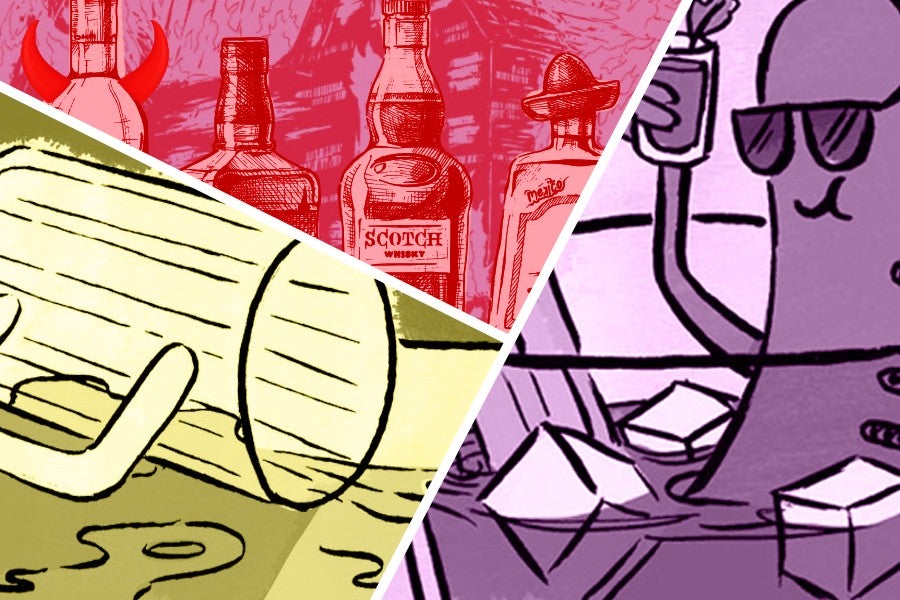Boozing can go one of two ways: Very right, or very (very!) wrong. You can sometimes avoid the latter if you know what you’re doing, which is why we’ve taken the time to learn how to hit the bottle without getting ourselves into trouble. As a public service in the hours before the biggest drinking holiday of the year (this side of St. Patrick’s Day at least), here are a few of our lessons toward that end…

Rule #1: Beer before liquor will make you sicker.
“You may be inclined to drink more alcohol by following beer with liquor than you would following liquor with beer — and that’s the real culprit behind your misery the next morning.”
Rule #2: Don’t overdo hair of the dog.
“Recall that this is now medicinal booze, so unlike the firehose you pointed at your face the night before, it’s about application, not volume. The trick, of course, is to drink just enough, but not too much, to knock the hangover off course and still get through the day, either at work or just lying around feeling like utter shit.”
Rule #3: Learn how to secretly piss yourself in public.
“From makeshift catheters to diapers to fake putters, drunk men have refined the art of pissing their pants in style — or more accurately, pissing their pants somewhat secretively with the piss properly gathered somewhere other than the fabric of their jeans, khakis, etc.”
Rule #4: Food is your friend.
“Booze actually causes your stomach to drain more slowly, which means anything you eat will sit in the stomach for longer. This, in turn, means that additional booze will take longer to get into your bloodstream, and that’s the point: You want a blotter to keep soaking up that booze so you can keep drinking and never get too drunk.”
Rule #5: The sun is not your friend.
“Not only does it make you more dehydrated, but the heat mixed with the booze can also increase your risk of heat stroke. Plus, you’re not the greatest at keeping track of time right now, which increases the probability of sunburn.”
Rule #6: Short skinny guys need to pay more attention to these rules than large bear-men.
“The human body is made up of more water than anything else. This water is mostly stored in your blood, so the taller and heavier a person is, the more extensive their circulatory system is, and the more water they are carrying around. This is important because when alcohol enters the bloodstream, it gets diluted by the water there, lessening its impact.”
Rule #7: No, you can’t drink in an Uber.
“Lyft makes it explicit: It’s not allowed. ‘Be sure to toss that adult beverage before your driver arrives,’ the passenger guidelines state clearly. ‘Open containers are not allowed in the car, and turning a blind eye to them can result in deactivation from our platform.’ Uber’s stated community guidelines say that users can be banned for a variety of activities — one of which is breaking the local law while using Uber. ‘For example,’ they write, ‘bringing open containers of alcohol or drugs into the car.’”
Rule #8: Drinking in moderation is good for you.
“Various studies show that moderate drinking (defined by such studies as fewer than three drinks per day) is associated with decreased risk of heart attack and coronary artery disease. On top of that, drinking moderately may also boost your brain health — e.g., a 2011 study suggests that it helps protect against dementia.”
Rule #9: When at the bar, keep a tab open.
“Unless you’re paying with cash, do NOT pay as you go. Even if you only have one drink, open a tab. In fact, it’s been estimated that bartenders spend as much as two hours a shift taking and making payments. That’s why many bars have $10 or $20 minimums on credit-card transactions.”
Rule #10: And tip appropriately!
“Twenty percent of the total bill amount is the standard tipping benchmark, and this carries over to cocktails. That $15 coconut ginger Thai basil concoction you ordered costs $15 largely because it’s a huge pain in the ass to make. In other words, if your group orders four of these monstrosities and the tab is $60, a $4 tip doesn’t cut it.”
Rule #11: Avoid vodka at all costs.
“On the off-chance you end up behind bars after going down a booze-fueled wormhole, it’s most likely vodka that put you there. A whopping 45 percent of respondents in a recent survey who admitted that a night of drinking had led to a night in the slammer indicated that they were drinking vodka before the cuffs went on, compared to just 11 percent who were drinking tequila.”
Rule #12: Order your drinks neat, or you’ll get fat.
“The empty calories in alcohol can be increased tenfold with the addition of fizzy drinks, or the sugar added to cocktails and found in processed fruit juices. In other words, you’re gonna need to give up the Cuba Libres or start having the rum contained therein either on the rocks or with freshly squeezed juice. If you’re drinking liquor straight up, you’re also more likely to have better control of how much alcohol you consume, which can help you significantly reduce the number of calories you ultimately ingest.”
Rule #13: Booze early — you’ll sleep better.
“Aaron White, senior scientific adviser at the National Institute of Alcohol Abuse and Alcoholism, theorizes that boozing earlier in the day — rather than late at night — may work out better for your sleep, since a belly full of booze before bed disrupts your sleeping patterns. (This only applies if you have the willpower to avoid going into a full-day bender.)”
Rule #14: Stick to top-shelf booze.
“Congeners are byproducts of the fermentation process that our bodies struggle to process. As a result, alcoholic beverages containing more congeners result in worse hangover symptoms — and it’s widely believed that because cheap booze begins with lower-quality ingredients, more congeners are produced during the fermentation process.”
Rule #15: Avoid drugs and hard liquor if you’re prone to blacking out.
“Liquor is a major contributor (in studies, people rarely reported blacking out by sticking only to beer). Other drugs — pot, Valium, Xanax, Rohypnol or other benzos — can bring on blackouts far more easily, too. Studies also show that people who regularly binge drink are more likely to suffer blackouts. It’s basically a positive feedback loop where the more often you get them, the more prone you are to getting them in the future.”

